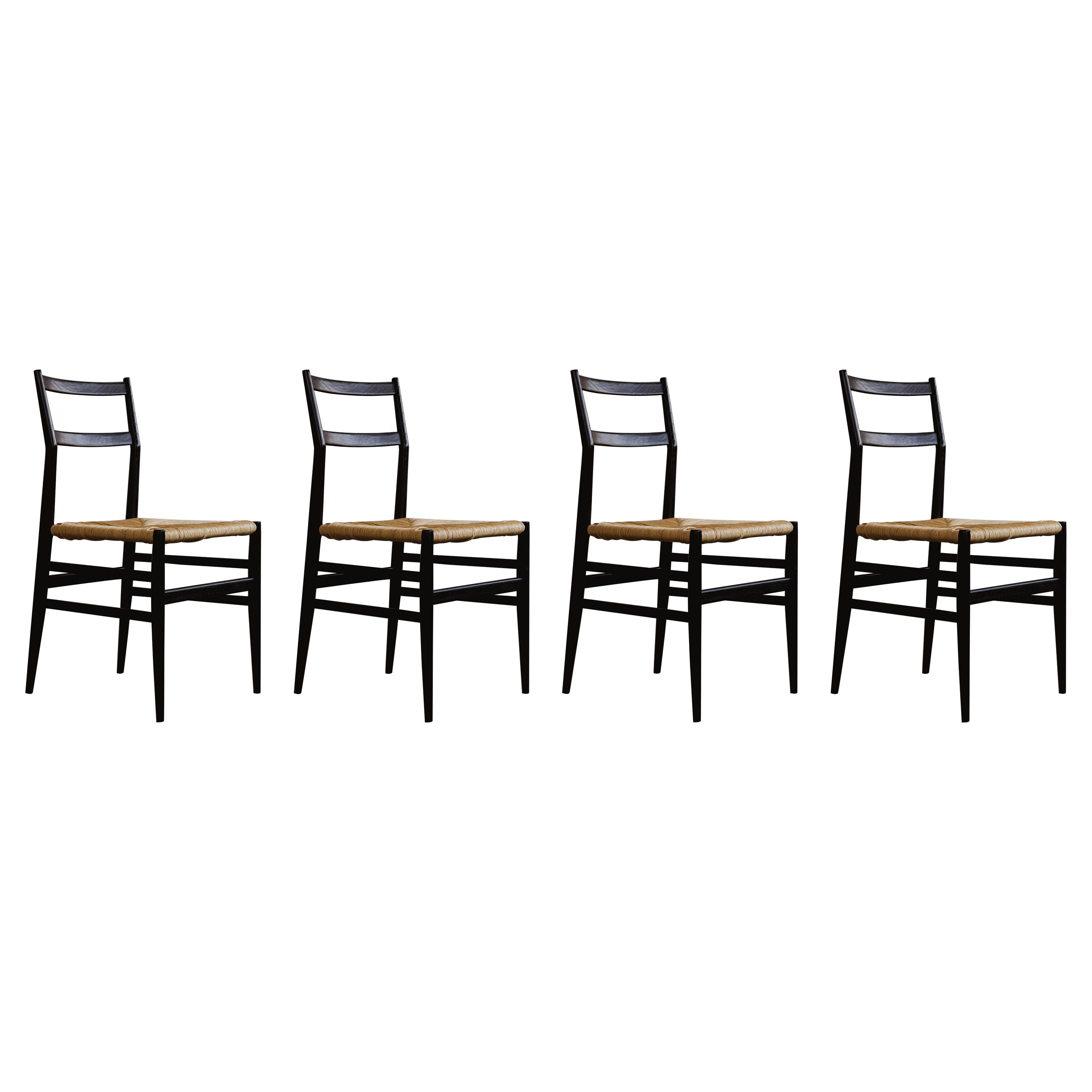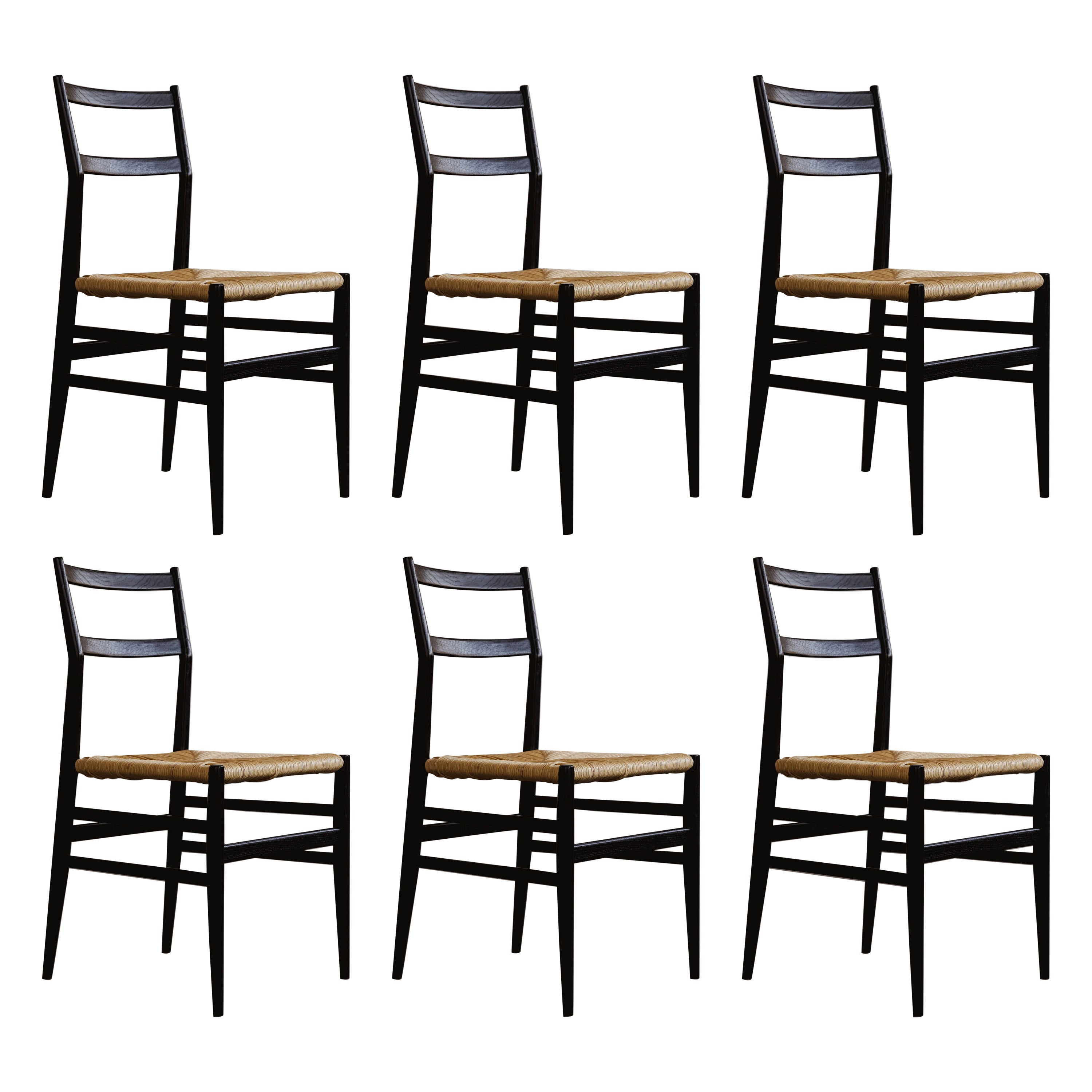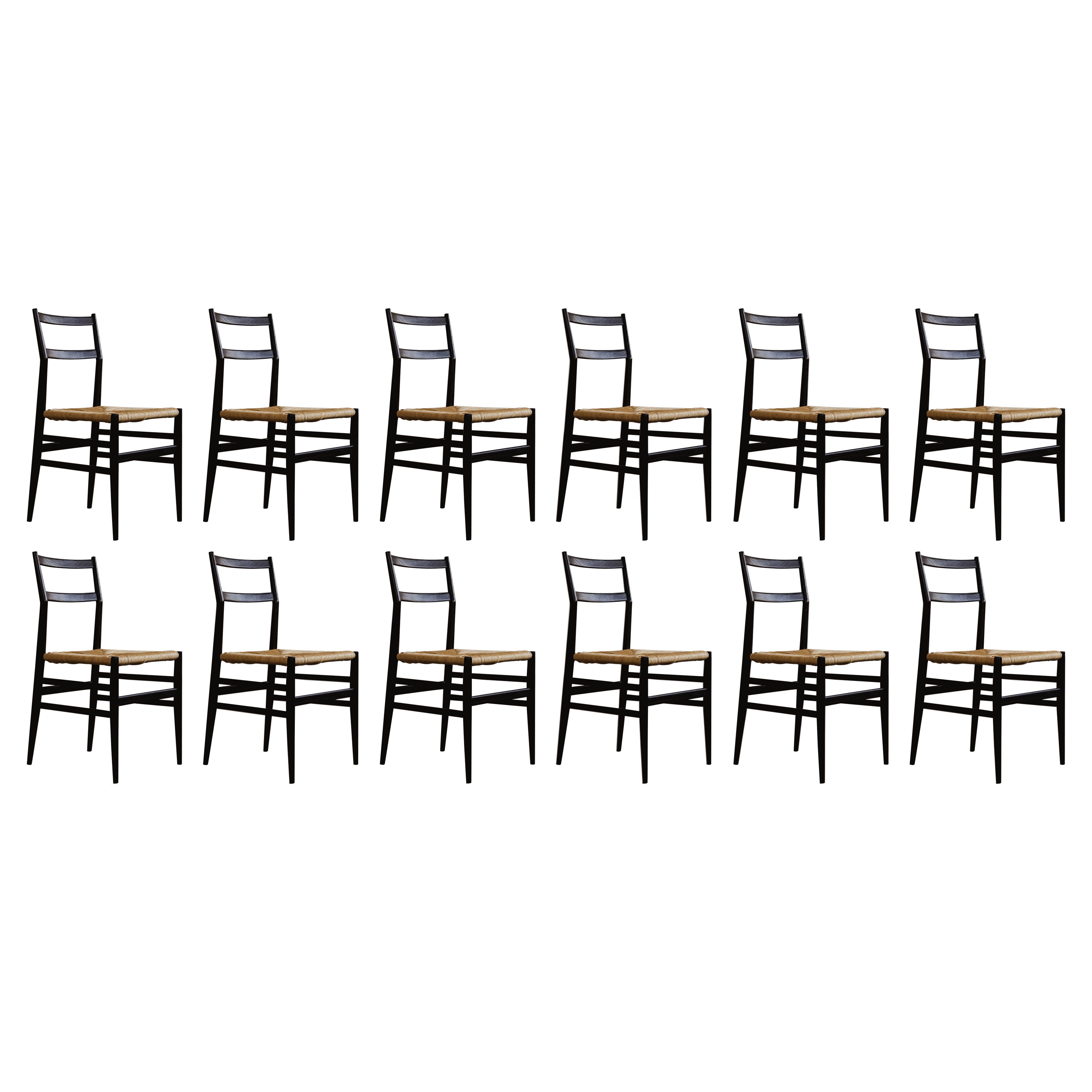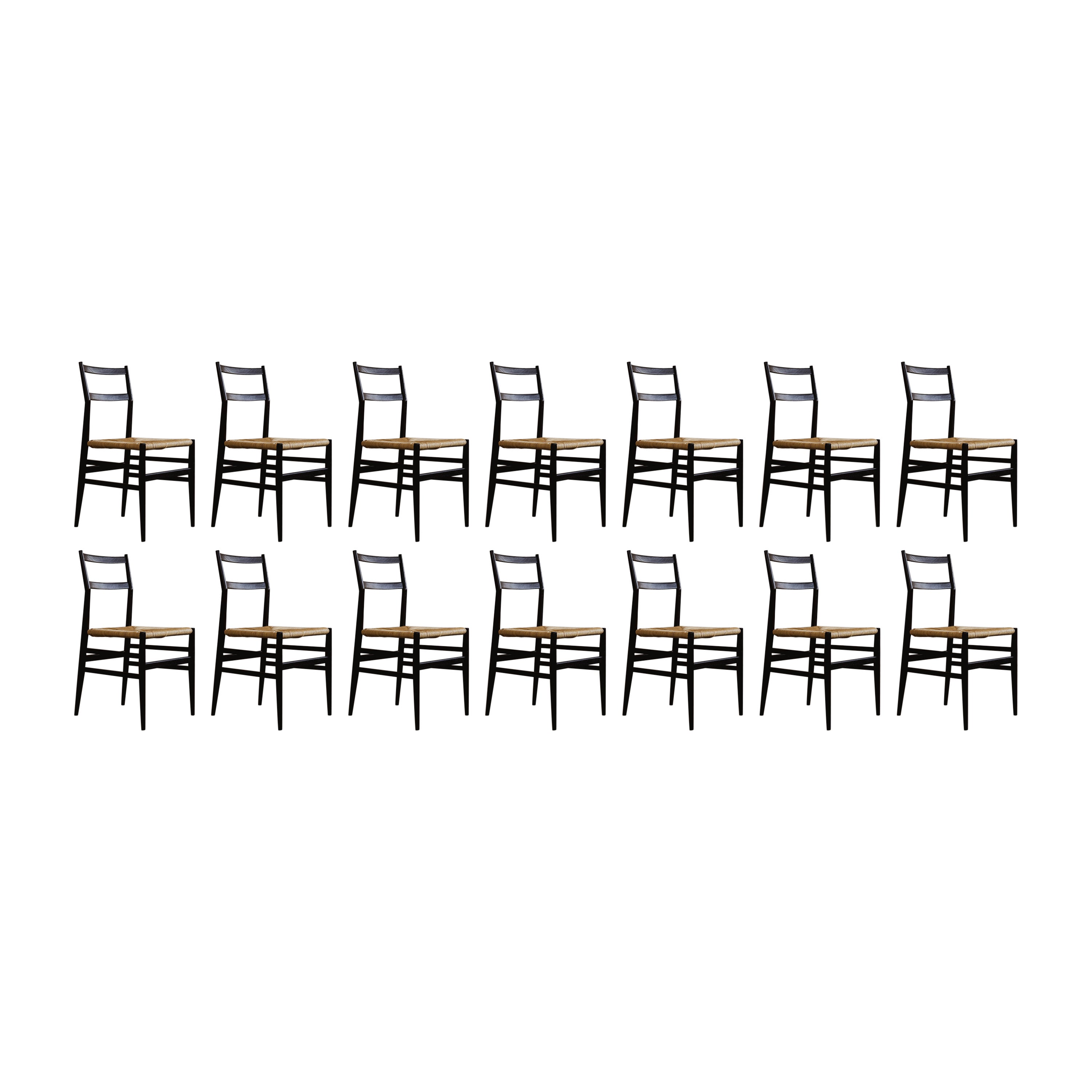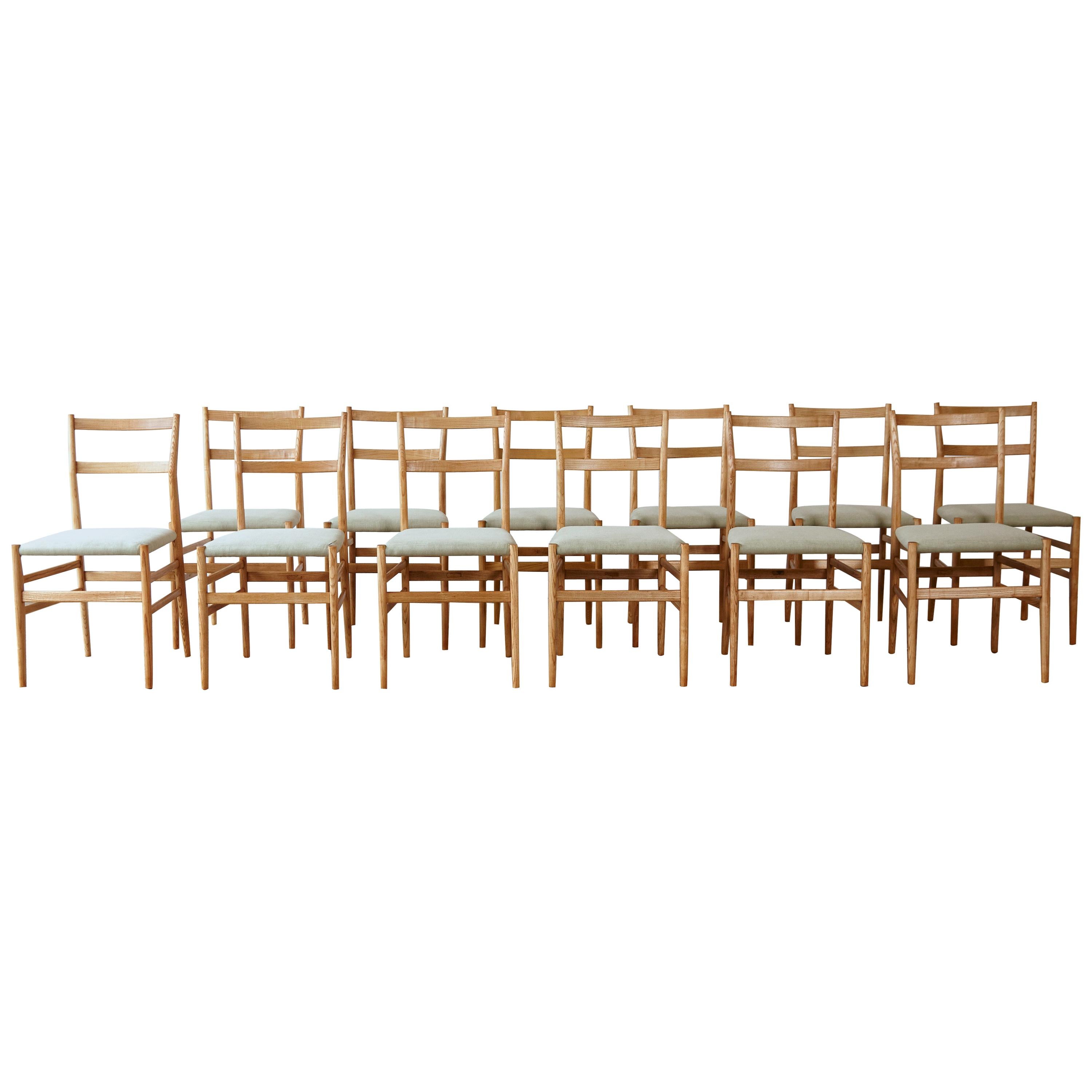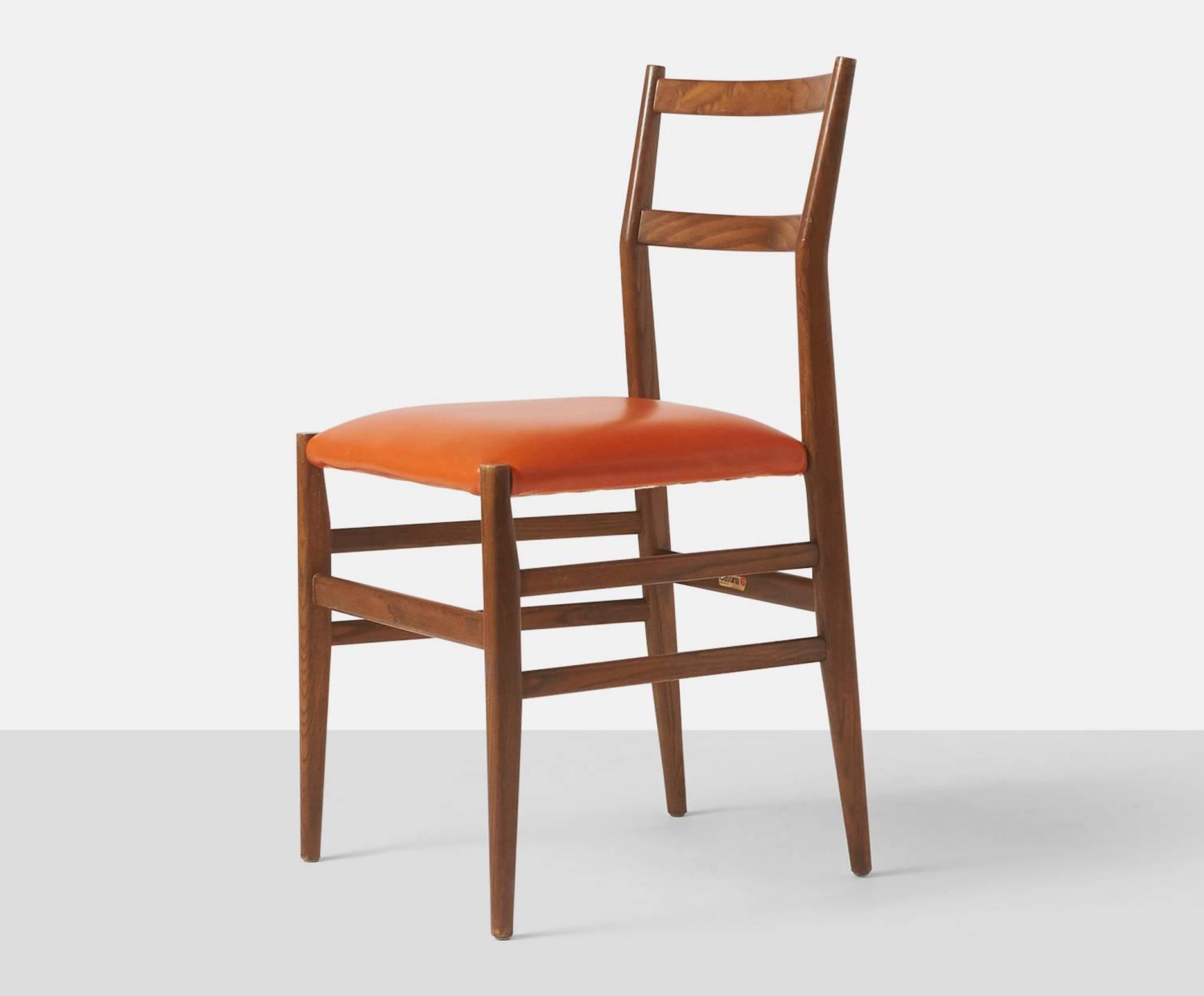rare Gio Ponti leggera chair, n.646 by Cassina, from Hotel Royal Naples, 1955
About the Item
- Creator:Gio Ponti (Designer)
- Design:
- Dimensions:Height: 32.88 in (83.5 cm)Width: 16.93 in (43 cm)Depth: 18.9 in (48 cm)Seat Height: 17.33 in (44 cm)
- Style:Modern (Of the Period)
- Materials and Techniques:
- Place of Origin:
- Period:
- Date of Manufacture:1955
- Condition:Reupholstered. Wear consistent with age and use.
- Seller Location:Rome, IT
- Reference Number:1stDibs: LU950037135832
Leggera
The Leggera chair is as striking on its own as it is in any setting, which is just as Giò Ponti (1891–1979) intended.
The gifted Milanese architect — who also designed, taught and wrote — studied architecture at the esteemed Polytechnic University of Milan, graduating in 1921. A stint in an architectural office followed, as did award-winning porcelain designs for Richard Ginori. In 1928, Ponti launched the revered design journal Domus, promoting the Novocento movement, which decried the “fake antique” and “ugly modern” in architecture and design. This was very much in line with Ponti’s own distinct style, which united the historical classicism of Italy with a modern ideal. The furniture maker’s work to this day exudes that spirit of innovation and timelessness, just as it did with the Leggera chair.
Ponti brought new meaning to traditional Italian country furniture with the 1952 Leggera chair and the Superleggera that followed — specifically, he looked to the simple but well-known chairs designed in Chiavari, a nearby fishing village, for inspiration. The Leggera’s gently tapering legs, ladder back and cane seat are features that render it easily recognizable to any collector. And like most of Ponti’s furniture, its tapering supports and lightweight ashwood frame — leggera is Italian for “light” — give it a ballerina-like appearance, as if the chair is dancing on its toes. First produced by Cassina, the Leggera also represented a bold step in its reductionist construction. The frame of the chair was pared down to its most essential lines, offering the illusion of weightlessness, like Ponti’s best work.
Gio Ponti
An architect, furniture and industrial designer and editor, Gio Ponti was arguably the most influential figure in 20th-century Italian modernism.
Ponti (1891–1979) designed thousands of furnishings and products — from cabinets, lamps and chairs to ceramics and coffeemakers — and his buildings, including the brawny Pirelli Tower (1956) in his native Milan, and the castle-like Denver Art Museum (1971), were erected in 14 countries. Through Domus, the magazine he founded in 1928, Ponti brought attention to virtually every significant movement and creator in the spheres of modern art and design.
The questing intelligence Ponti brought to Domus is reflected in his work: as protean as he was prolific, Ponti’s style can’t be pegged to a specific genre. In the 1920s, as artistic director for the Tuscan porcelain maker Richard Ginori, he fused old and new; his ceramic forms were modern, but decorated with motifs from Roman antiquity. In pre-war Italy, modernist design was encouraged, and after the conflict, Ponti — along with designers such as Carlo Mollino, Franco Albini, Marco Zanuso — found a receptive audience for their novel, idiosyncratic work. Ponti’s typical furniture forms from the period, such as the wedge-shaped Distex chair, are simple, gently angular, and colorful; equally elegant and functional. In the 1960s and ’70s, Ponti’s style evolved again as he explored biomorphic shapes, and embraced the expressive, experimental designs of Ettore Sottsass Jr., Joe Colombo and others.
His signature furniture piece — the one by which he is represented in the collections of the Museum of Modern Art in New York, Germany’s Vitra Design Museum and elsewhere — is the sleek Superleggera chair, produced by Cassina starting in 1957. (The name translates as “superlightweight” — advertisements featured a model lifting it with one finger.) Ponti had a playful side, best shown in a collaboration he began in the late 1940s with the graphic artist Piero Fornasetti. Ponti furnishings were decorated with bright finishes and Fornasetti's whimsical lithographic transfer prints of things such as butterflies, birds or flowers; the Montreal Museum of Fine Arts possesses a 1950 secretary from their Architetturra series, which feature case pieces covered in images of building interiors and facades. The grandest project Ponti and Fornasetti undertook, however, lies on the floor of the Atlantic Ocean: the interiors of the luxury liner Andrea Doria, which sank in 1956.
Widely praised retrospectives at the Queens Museum of Art in 2001 and at the Design Museum London in 2002 sparked a renewed interest in Ponti among modern design aficionados. (Marco Romanelli’s monograph written for the London show, offers a fine overview of Ponti’s work.) Today, a wide array of Ponti’s designs are snapped up by savvy collectors who want to give their homes a touch of Italian panache and effortless chic.
Find a range of Gio Ponti furniture on 1stDibs.
- ShippingRetrieving quote...Ships From: Luni (la Spezia) , Italy
- Return PolicyA return for this item may be initiated within 2 days of delivery.
- Pair of Large Gio Ponti Cherrywood Boiserie Panels from Hotel Royal, Naples 1955By Giordano Chiesa, Gio PontiLocated in Rome, ITA pair of unique Gio Ponti wood panels from the furniture of the Hotel Royal in Naples, 1955. Manufactured by Giordano Chiesa by Dassi. cherrywood thick edge with owl's beak these pi...Category
Vintage 1950s Italian Mid-Century Modern Architectural Elements
MaterialsCherry
- Gio Ponti Walnut Side Table, Luggage Rack for Hotel Royal Naples, 1955By Giordano Chiesa, Gio PontiLocated in Rome, ITGio Ponti side table (stand) produced by Giordano Chiesa, from the suite of the Hotel Royal Naples, 1955 Italian walnut, brass. Brass details: Handles, foot and seven sections five walnut sticks Measures: Height 64 cm, 65 x 42 cm; height without handle 51 cm These item come directly from the original furniture of the Hotel (original Hotel...Category
Vintage 1950s Italian Mid-Century Modern Side Tables
MaterialsBrass
- Pair of Gio Ponti Black Walnut Lacquered Side Tables from Hotel Royal NaplesBy Giordano Chiesa, Gio PontiLocated in Rome, ITPair of luggage-racks, side tables designed by Gio Ponti and executed by Giordano Chiesa for the Hotel Royal, Naples, 1955 in 2005 arch. Cristina Longo used original items from Hotel Royal in Naples and she has made 10 limited editon pair of stands in black lacquered for a private residence in Rome, Italy ( pubblished in AD ITALY, march 2010) Italian lacquered walnut, brass. Brass details: Handles, foot and seven sections on top (each Stand) this version is with three horizontal slats in the Sub-shelfs and different brass sabots limted edition: n. 10 of 10 Measures: Height 65 cm; 65x 42 cm, height without handle 51,5 cm These items comes directly form the original furniture of the Hotel in Naples (original Hotel Royal invoice). Sold with a copy of a letter of authentication from Lisa Licitra Ponti. a pair of luggage racks from the same private provenience (compendio gallery...Category
Vintage 1950s Italian Mid-Century Modern Side Tables
MaterialsBrass
- Gio Ponti, pair Walnut Headboards with fitted bedside tables, Hotel Royal, 1955By Giordano Chiesa, Gio PontiLocated in Rome, ITA pair of headboards by Gio Ponti from the furniture of the Hotel Royal in Naples, 1955. Manufactured by Giordano Chiesa by Dassi. walnut and metal two tiered shelving, magazine rac...Category
Vintage 1950s Italian Mid-Century Modern Beds and Bed Frames
MaterialsMetal
- Gio Ponti, pair flamed wood Headboard, fitted bedside tables, Hotel Royal, 1955By Giordano Chiesa, Gio PontiLocated in Rome, ITA pair of headboards by Gio Ponti from the furniture of the Hotel Royal in Naples, 1955. Manufactured by Giordano Chiesa by Dassi. flamed walnut, finish mahogany and metal two tiere...Category
Vintage 1950s Italian Mid-Century Modern Beds and Bed Frames
MaterialsMetal
- pair of GIO PONTI oak hanging nightstand tables, side tables Hotel Royal, 1955By Giordano Chiesa, Gio PontiLocated in Rome, ITpair of hanging oak wood nightstands or bed side tables by Gio Ponti wall mounted two shelves side tables finishing of the owl's beak top part of a pair of original headboards whe...Category
Vintage 1950s Italian Mid-Century Modern Side Tables
MaterialsOak
- Gio Ponti 646 "Leggera" Dining Chairs for Cassina, 1952, Set of 4By Gio Ponti, CassinaLocated in Lonigo, VenetoGio Ponti 646 "Leggera" dining chairs for Cassina, black ash-wood and rope seat, Italy, 1952, set of four. The model 646 "Leggera" is an icon of chai...Category
Vintage 1950s Italian Mid-Century Modern Dining Room Chairs
MaterialsRope, Ash
- Gio Ponti 646 "Leggera" Dining Chairs for Cassina, 1952, Set of 6By Gio Ponti, CassinaLocated in Lonigo, VenetoGio Ponti 646 "Leggera" dining chairs for Cassina, black ash-wood and rope seat, Italy, 1952, set of six. The model 646 "Leggera" is an icon of chair...Category
Vintage 1950s Italian Mid-Century Modern Dining Room Chairs
MaterialsRope, Ash
- Gio Ponti 646 "Leggera" Dining Chairs for Cassina, 1952, Set of 14By Cassina, Gio PontiLocated in Lonigo, VenetoGio Ponti 646 "Leggera" dining chairs for Cassina, black ash-wood and rope seat, Italy, 1952, set of fourteen. The model 646 "Leggera" is an icon of chair design and of Cassina’s...Category
Vintage 1950s Italian Mid-Century Modern Dining Room Chairs
MaterialsRope, Ash
- Gio Ponti 646 "Leggera" Dining Chairs for Cassina, 1952, Set of 12By Gio Ponti, CassinaLocated in Lonigo, VenetoGio Ponti 646 "Leggera" dining chairs for Cassina, black ash-wood and rope seat, Italy, 1952, set of twelve. The model 646 "Leggera" is an icon of ch...Category
Vintage 1950s Italian Mid-Century Modern Dining Room Chairs
MaterialsRope, Ash
- Gio Ponti 646 "Leggera" Dining Chairs for Cassina, 1952, Set of 10By Gio Ponti, CassinaLocated in Lonigo, VenetoGio Ponti 646 "Leggera" dining chairs for Cassina, black ash-wood and rope seat, Italy, 1952, set of ten. The model 646 "Leggera" is an icon of chair...Category
Vintage 1950s Italian Mid-Century Modern Dining Room Chairs
MaterialsRope, Ash
- Set of 12 Gio Ponti Leggera Model 646 Dining Chairs for Cassina, Italy, 1950sBy Gio Ponti, CassinaLocated in London, GBA wonderful set of twelve original, early Gio Ponti Leggera Model 646 dining chairs, Cassina, Italy, 1950s. In restored condition with new ...Category
Mid-20th Century Italian Mid-Century Modern Dining Room Chairs
MaterialsFabric, Wood
Recently Viewed
View AllRead More
Billy Cotton Layers His Interiors with Lived-In Comfort
The Brooklyn-based designer is adept at styles ranging from austere to over-the-top, espousing an architectural, detail-oriented approach also evident in his line of furniture and lighting.
Barnaba Fornasetti’s Hallucinatory House Has His Father’s Spirit
Behind a nondescript facade in northeastern Milan is the magical residence of Barnaba Fornasetti. It's a shrine to the style developed by his design-legend father, which still defies categorization.
